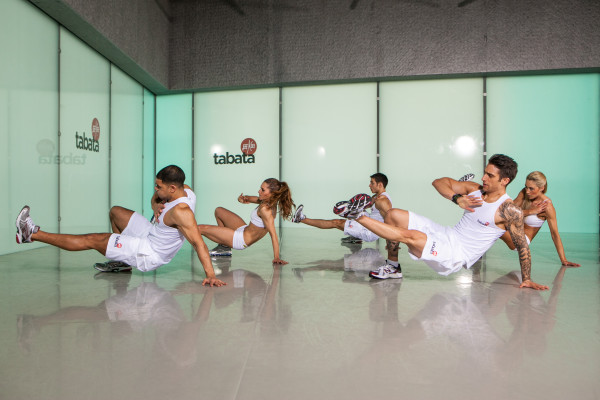With high-intensity interval training topping the American College of Sports Medicine’s list of fitness trends for 2014*, it looks like interval-style workouts are here to stay. We decided to take a closer look – and, we have to admit, we got a little bit flummoxed. tabataTM, HIIT… why do we have so many confusing names for working out? What’s the difference? Are they all high-intensity intervals or what? More importantly are they any cop? If you’re as discombobulated as we were, here’s the lowdown.
So what’s HIIT then?
HIIT is a term you hear bandied around a lot in the fitness world these days, but what the chuff is it? An acronym of high-intensity interval training (sometimes called just HIT – high intensity training), HIIT involves bursts of intense activity interspersed with periods of rest or lower impact activity. So 30 seconds of sprinting or squat jumps followed by 30 secs of rest or walking for example. It’s not a new idea, just check out any old-school circuit class or marathon training programme for proof, but as they say, if it ain’t broke, don’t fix it. Just jazz it up a bit, incorporate some of the newer moves and fitness findings, et voila. You get a fun workout.
What are the benefits?
According to Susan Dyson, founder of Hiitgirl, a studio in North London dedicated to HIIT classes, it’s the perfect way to get a good workout in a short space of time. “We base our workouts on HIIT Training for many reasons but it really boils down to two things – time and results. Our customers are busy women who want to get in the best possible shape but don’t have hours to spend in the gym (all our workouts last just 30 minutes). With HIIT training you can spend less time and get better results as you’re working hard – very hard – in a short period of time. A good HIIT workout will raise your metabolism too, meaning the benefits can continue for up to 24 hours so it’s incredibly efficient on all fronts.”
It’s also a very convenient way of working out. In its simplest form, HIIT training involves working against your body weight so you can do it pretty much anywhere with no equipment. If you want to mix it up there are lots of fitness toys you can use that don’t cost the earth and add variety to every workout. Things such as sandbags, furniture sliders, resistance bands and medicine balls are perfect, no matter what fitness level you start at.”
Try it yourself
“If you want to try HIIT Training you’ll need to make sure you don’t push it to the max at the beginning,” advises Susan. “Spend some time getting used to this type of workout by keeping your work intervals shorter than your rest intervals. Then slowly reduce the rest time until you can do 30 seconds of work followed by 30 seconds of rest. Invest in a timer app to keep you focused and aim to do 15-30 minutes three times a week for the best results.”
For info about Hiitgirl classes visit hiitgirl.com, Hiitgirl also publish regular 5-minute fitness challenges on YouTube check them out and try it at home.
Read Emma’s review of Hiitgirl here
And what’s tabataTM?
Well turns out, it’s another form of HIIT. Confusion cleared. It’s a very specific type of HIIT though, with just four minutes of intense exercise in a session – 20 second high-intensity bursts of all-out effort followed by 10 seconds of rest, repeated eight times. Named after Professor Izumi Tabata, the Japanese scientist who devised it, the idea for this workout came about when Tabata was working with the Japanese Olympic speed skating team. He found that short sharp bursts of intense exercise were more effective in improving fitness faster, increasing VO2 max (maximal aerobic capacity) by around 13% in six weeks.
What are the benefits?
Similar to any HIIT training – convenience, time and quick results. tabataTM classes are usually just 20 mins in total with a warm up to mobilise your joints, four hard minutes working at near maximum heart rate – including explosive jumps and lunges – and then a cool down. Perfect for doing on your lunch break or before work. Be warned though, the workout may be short but it’s pretty intense (ie, if you do it at lunchtime you will need a shower afterwards, unless you hate your colleagues obvs).
Although you would get fit doing this type of workout on its own, tabataTM master trainer Richard Scrivener says this type of workout is particularly effective as an addition to your existing training regime. “tabata uses a number of moves that build your explosive strength so it’s great for sports and training such as football and sprinting where you need that extra power.”
Try it yourself
“The key is to go all out in the 20 seconds says Richard. “It’s tempting to hold something back but you won’t get the results or feel like you’ve worked hard enough at the end.”
Having tried tabata myself I think it’d be pretty hard to push yourself hard enough on your own, unless you’re very focused/hardcore the temptation to slack off a bit can be pretty strong so it’s best done in a class or with a personal trainer.
Official tabata classes are available in selected gyms Nationwide. For more information visit www.tabataofficial.com
*American College of Sports Medicine’s list of fitness trends for 2014*






Ooh I love HIIT, I do regular classes but our HIIT class is more like a Tabata session from reading this, with 50 seconds exercise (ouch!) and only 10 seconds rest.
It hurts, but it’s the best workout of the week by far. 🙂